University Criminology Report: CCTV Surveillance and Human Rights
VerifiedAdded on 2023/01/20
|6
|1418
|55
Report
AI Summary
This report provides an in-depth analysis of CCTV surveillance within the context of criminology and criminal justice in Australia. The paper examines the increasing deployment of CCTV systems in public and private spaces as a crime prevention measure, highlighting the investments made by government and private sectors. It explores the effectiveness of CCTV in identifying offenders and aiding police investigations, including its role in providing evidence for criminal trials and deterring crime. The report discusses the impact of CCTV on privacy, civil liberties, social justice, and human rights, addressing the challenges and criticisms associated with surveillance programs, particularly concerning potential infringements on individual privacy. The author concludes by acknowledging the ongoing debate surrounding the balance between public safety and the protection of citizens' rights in the face of evolving surveillance technologies.
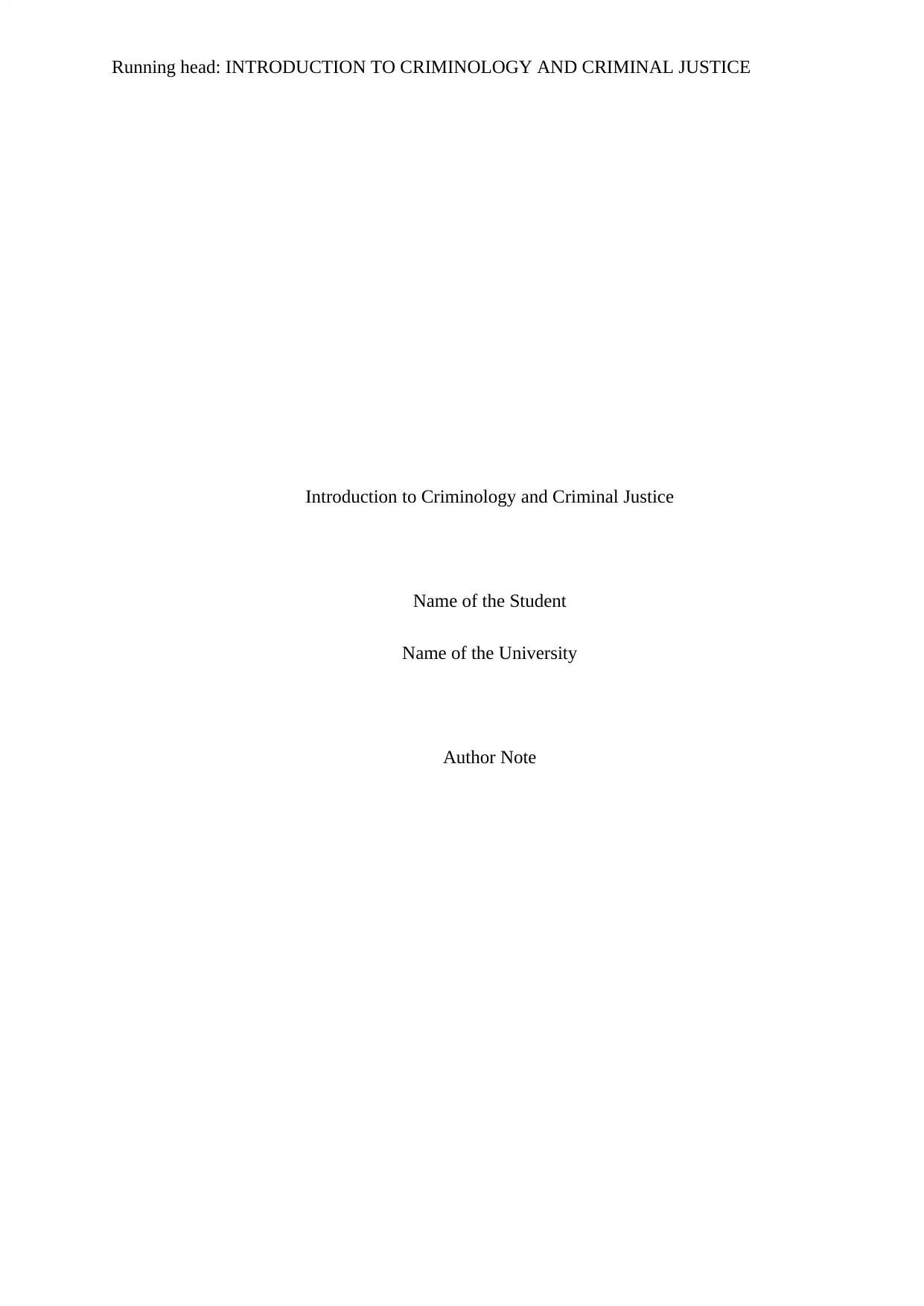
Running head: INTRODUCTION TO CRIMINOLOGY AND CRIMINAL JUSTICE
Introduction to Criminology and Criminal Justice
Name of the Student
Name of the University
Author Note
Introduction to Criminology and Criminal Justice
Name of the Student
Name of the University
Author Note
Paraphrase This Document
Need a fresh take? Get an instant paraphrase of this document with our AI Paraphraser
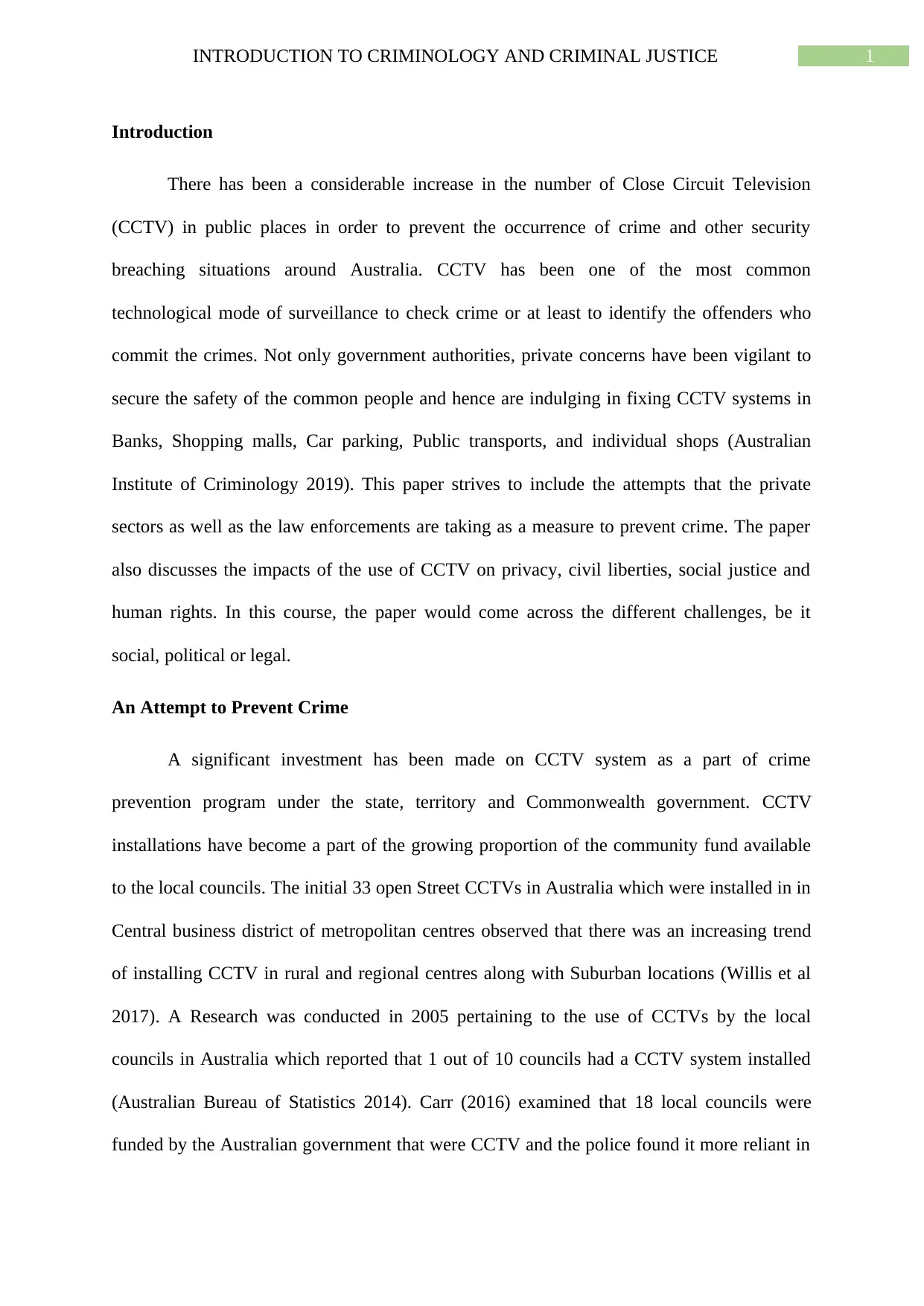
1INTRODUCTION TO CRIMINOLOGY AND CRIMINAL JUSTICE
Introduction
There has been a considerable increase in the number of Close Circuit Television
(CCTV) in public places in order to prevent the occurrence of crime and other security
breaching situations around Australia. CCTV has been one of the most common
technological mode of surveillance to check crime or at least to identify the offenders who
commit the crimes. Not only government authorities, private concerns have been vigilant to
secure the safety of the common people and hence are indulging in fixing CCTV systems in
Banks, Shopping malls, Car parking, Public transports, and individual shops (Australian
Institute of Criminology 2019). This paper strives to include the attempts that the private
sectors as well as the law enforcements are taking as a measure to prevent crime. The paper
also discusses the impacts of the use of CCTV on privacy, civil liberties, social justice and
human rights. In this course, the paper would come across the different challenges, be it
social, political or legal.
An Attempt to Prevent Crime
A significant investment has been made on CCTV system as a part of crime
prevention program under the state, territory and Commonwealth government. CCTV
installations have become a part of the growing proportion of the community fund available
to the local councils. The initial 33 open Street CCTVs in Australia which were installed in in
Central business district of metropolitan centres observed that there was an increasing trend
of installing CCTV in rural and regional centres along with Suburban locations (Willis et al
2017). A Research was conducted in 2005 pertaining to the use of CCTVs by the local
councils in Australia which reported that 1 out of 10 councils had a CCTV system installed
(Australian Bureau of Statistics 2014). Carr (2016) examined that 18 local councils were
funded by the Australian government that were CCTV and the police found it more reliant in
Introduction
There has been a considerable increase in the number of Close Circuit Television
(CCTV) in public places in order to prevent the occurrence of crime and other security
breaching situations around Australia. CCTV has been one of the most common
technological mode of surveillance to check crime or at least to identify the offenders who
commit the crimes. Not only government authorities, private concerns have been vigilant to
secure the safety of the common people and hence are indulging in fixing CCTV systems in
Banks, Shopping malls, Car parking, Public transports, and individual shops (Australian
Institute of Criminology 2019). This paper strives to include the attempts that the private
sectors as well as the law enforcements are taking as a measure to prevent crime. The paper
also discusses the impacts of the use of CCTV on privacy, civil liberties, social justice and
human rights. In this course, the paper would come across the different challenges, be it
social, political or legal.
An Attempt to Prevent Crime
A significant investment has been made on CCTV system as a part of crime
prevention program under the state, territory and Commonwealth government. CCTV
installations have become a part of the growing proportion of the community fund available
to the local councils. The initial 33 open Street CCTVs in Australia which were installed in in
Central business district of metropolitan centres observed that there was an increasing trend
of installing CCTV in rural and regional centres along with Suburban locations (Willis et al
2017). A Research was conducted in 2005 pertaining to the use of CCTVs by the local
councils in Australia which reported that 1 out of 10 councils had a CCTV system installed
(Australian Bureau of Statistics 2014). Carr (2016) examined that 18 local councils were
funded by the Australian government that were CCTV and the police found it more reliant in
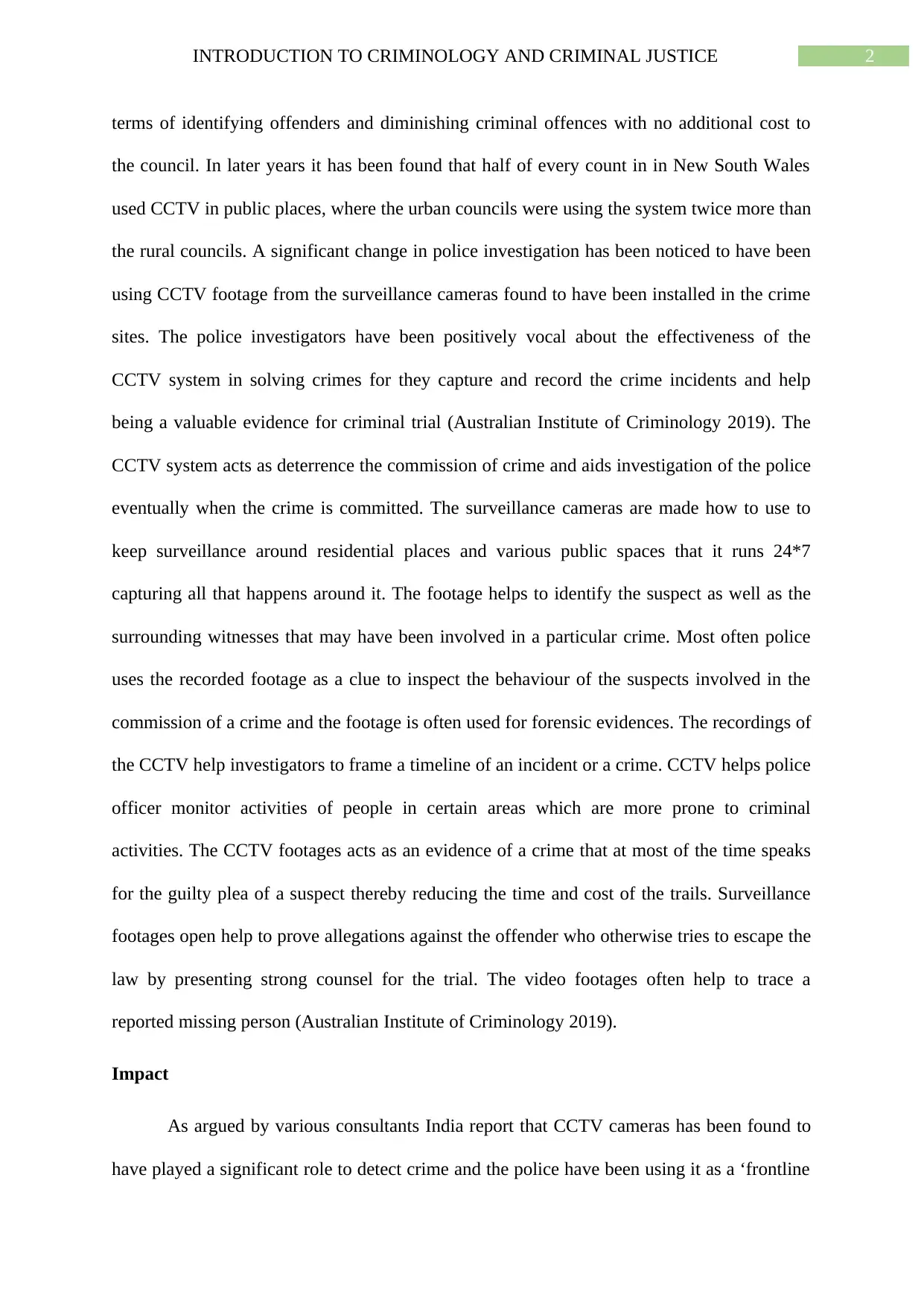
2INTRODUCTION TO CRIMINOLOGY AND CRIMINAL JUSTICE
terms of identifying offenders and diminishing criminal offences with no additional cost to
the council. In later years it has been found that half of every count in in New South Wales
used CCTV in public places, where the urban councils were using the system twice more than
the rural councils. A significant change in police investigation has been noticed to have been
using CCTV footage from the surveillance cameras found to have been installed in the crime
sites. The police investigators have been positively vocal about the effectiveness of the
CCTV system in solving crimes for they capture and record the crime incidents and help
being a valuable evidence for criminal trial (Australian Institute of Criminology 2019). The
CCTV system acts as deterrence the commission of crime and aids investigation of the police
eventually when the crime is committed. The surveillance cameras are made how to use to
keep surveillance around residential places and various public spaces that it runs 24*7
capturing all that happens around it. The footage helps to identify the suspect as well as the
surrounding witnesses that may have been involved in a particular crime. Most often police
uses the recorded footage as a clue to inspect the behaviour of the suspects involved in the
commission of a crime and the footage is often used for forensic evidences. The recordings of
the CCTV help investigators to frame a timeline of an incident or a crime. CCTV helps police
officer monitor activities of people in certain areas which are more prone to criminal
activities. The CCTV footages acts as an evidence of a crime that at most of the time speaks
for the guilty plea of a suspect thereby reducing the time and cost of the trails. Surveillance
footages open help to prove allegations against the offender who otherwise tries to escape the
law by presenting strong counsel for the trial. The video footages often help to trace a
reported missing person (Australian Institute of Criminology 2019).
Impact
As argued by various consultants India report that CCTV cameras has been found to
have played a significant role to detect crime and the police have been using it as a ‘frontline
terms of identifying offenders and diminishing criminal offences with no additional cost to
the council. In later years it has been found that half of every count in in New South Wales
used CCTV in public places, where the urban councils were using the system twice more than
the rural councils. A significant change in police investigation has been noticed to have been
using CCTV footage from the surveillance cameras found to have been installed in the crime
sites. The police investigators have been positively vocal about the effectiveness of the
CCTV system in solving crimes for they capture and record the crime incidents and help
being a valuable evidence for criminal trial (Australian Institute of Criminology 2019). The
CCTV system acts as deterrence the commission of crime and aids investigation of the police
eventually when the crime is committed. The surveillance cameras are made how to use to
keep surveillance around residential places and various public spaces that it runs 24*7
capturing all that happens around it. The footage helps to identify the suspect as well as the
surrounding witnesses that may have been involved in a particular crime. Most often police
uses the recorded footage as a clue to inspect the behaviour of the suspects involved in the
commission of a crime and the footage is often used for forensic evidences. The recordings of
the CCTV help investigators to frame a timeline of an incident or a crime. CCTV helps police
officer monitor activities of people in certain areas which are more prone to criminal
activities. The CCTV footages acts as an evidence of a crime that at most of the time speaks
for the guilty plea of a suspect thereby reducing the time and cost of the trails. Surveillance
footages open help to prove allegations against the offender who otherwise tries to escape the
law by presenting strong counsel for the trial. The video footages often help to trace a
reported missing person (Australian Institute of Criminology 2019).
Impact
As argued by various consultants India report that CCTV cameras has been found to
have played a significant role to detect crime and the police have been using it as a ‘frontline
⊘ This is a preview!⊘
Do you want full access?
Subscribe today to unlock all pages.

Trusted by 1+ million students worldwide
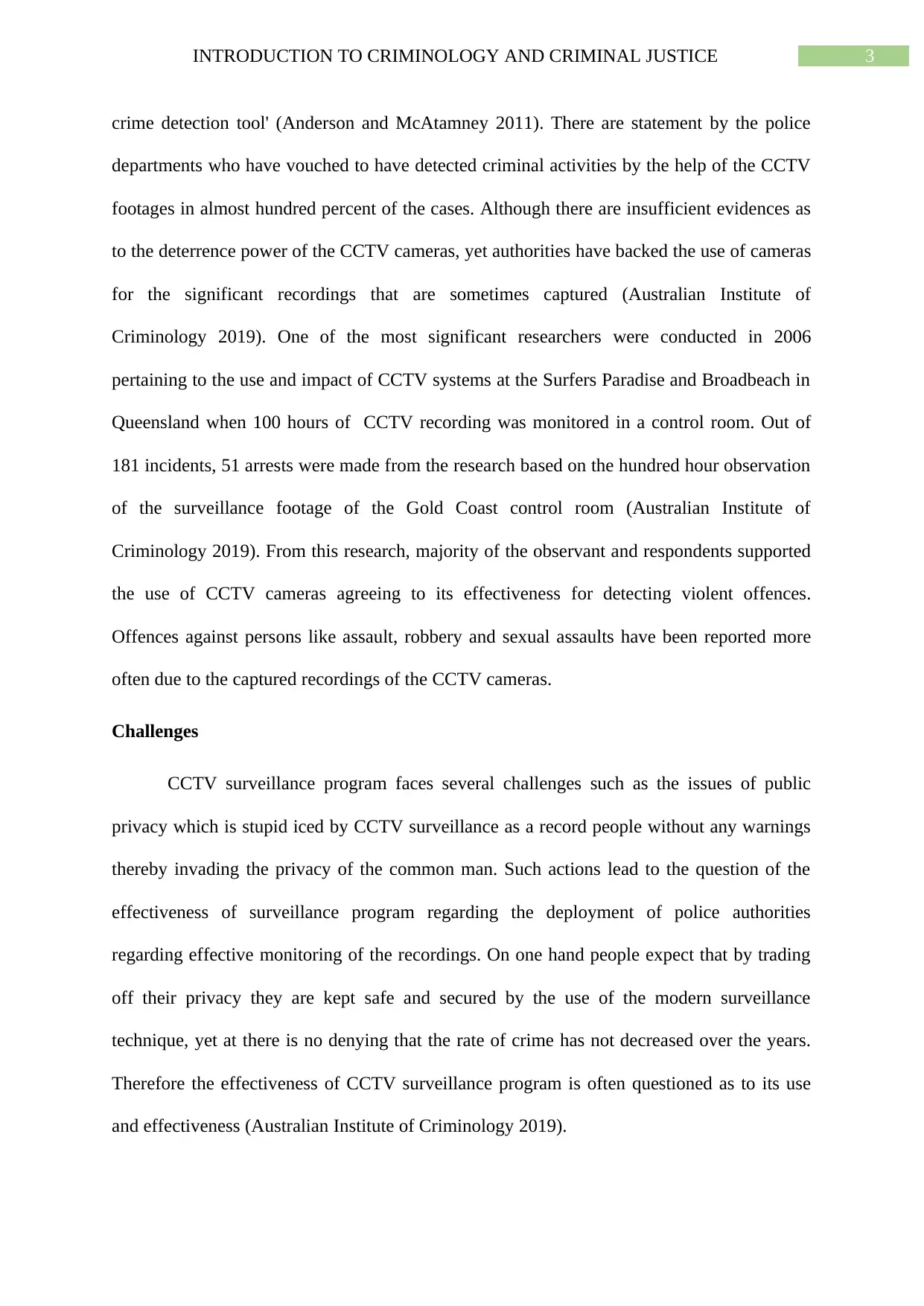
3INTRODUCTION TO CRIMINOLOGY AND CRIMINAL JUSTICE
crime detection tool' (Anderson and McAtamney 2011). There are statement by the police
departments who have vouched to have detected criminal activities by the help of the CCTV
footages in almost hundred percent of the cases. Although there are insufficient evidences as
to the deterrence power of the CCTV cameras, yet authorities have backed the use of cameras
for the significant recordings that are sometimes captured (Australian Institute of
Criminology 2019). One of the most significant researchers were conducted in 2006
pertaining to the use and impact of CCTV systems at the Surfers Paradise and Broadbeach in
Queensland when 100 hours of CCTV recording was monitored in a control room. Out of
181 incidents, 51 arrests were made from the research based on the hundred hour observation
of the surveillance footage of the Gold Coast control room (Australian Institute of
Criminology 2019). From this research, majority of the observant and respondents supported
the use of CCTV cameras agreeing to its effectiveness for detecting violent offences.
Offences against persons like assault, robbery and sexual assaults have been reported more
often due to the captured recordings of the CCTV cameras.
Challenges
CCTV surveillance program faces several challenges such as the issues of public
privacy which is stupid iced by CCTV surveillance as a record people without any warnings
thereby invading the privacy of the common man. Such actions lead to the question of the
effectiveness of surveillance program regarding the deployment of police authorities
regarding effective monitoring of the recordings. On one hand people expect that by trading
off their privacy they are kept safe and secured by the use of the modern surveillance
technique, yet at there is no denying that the rate of crime has not decreased over the years.
Therefore the effectiveness of CCTV surveillance program is often questioned as to its use
and effectiveness (Australian Institute of Criminology 2019).
crime detection tool' (Anderson and McAtamney 2011). There are statement by the police
departments who have vouched to have detected criminal activities by the help of the CCTV
footages in almost hundred percent of the cases. Although there are insufficient evidences as
to the deterrence power of the CCTV cameras, yet authorities have backed the use of cameras
for the significant recordings that are sometimes captured (Australian Institute of
Criminology 2019). One of the most significant researchers were conducted in 2006
pertaining to the use and impact of CCTV systems at the Surfers Paradise and Broadbeach in
Queensland when 100 hours of CCTV recording was monitored in a control room. Out of
181 incidents, 51 arrests were made from the research based on the hundred hour observation
of the surveillance footage of the Gold Coast control room (Australian Institute of
Criminology 2019). From this research, majority of the observant and respondents supported
the use of CCTV cameras agreeing to its effectiveness for detecting violent offences.
Offences against persons like assault, robbery and sexual assaults have been reported more
often due to the captured recordings of the CCTV cameras.
Challenges
CCTV surveillance program faces several challenges such as the issues of public
privacy which is stupid iced by CCTV surveillance as a record people without any warnings
thereby invading the privacy of the common man. Such actions lead to the question of the
effectiveness of surveillance program regarding the deployment of police authorities
regarding effective monitoring of the recordings. On one hand people expect that by trading
off their privacy they are kept safe and secured by the use of the modern surveillance
technique, yet at there is no denying that the rate of crime has not decreased over the years.
Therefore the effectiveness of CCTV surveillance program is often questioned as to its use
and effectiveness (Australian Institute of Criminology 2019).
Paraphrase This Document
Need a fresh take? Get an instant paraphrase of this document with our AI Paraphraser
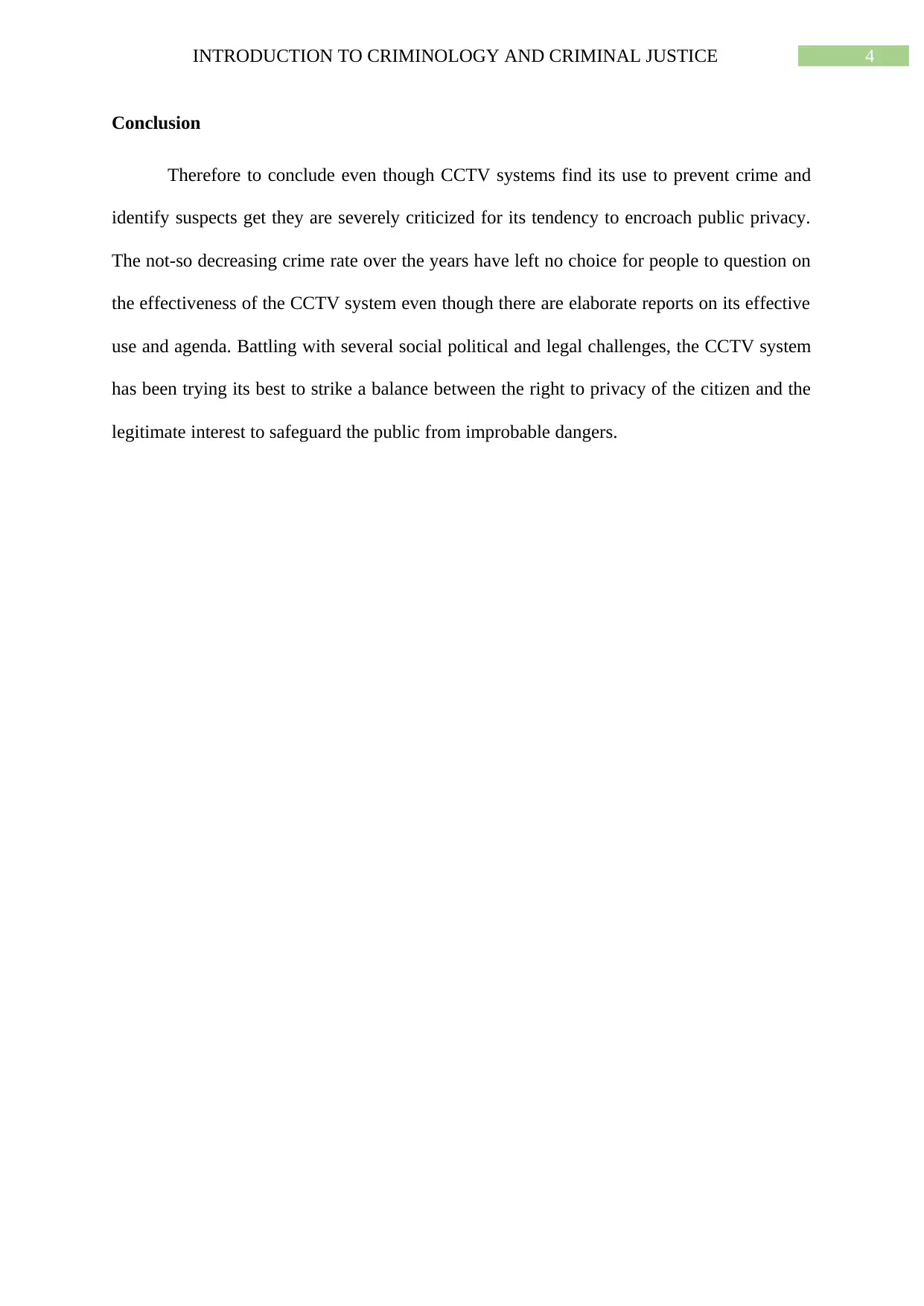
4INTRODUCTION TO CRIMINOLOGY AND CRIMINAL JUSTICE
Conclusion
Therefore to conclude even though CCTV systems find its use to prevent crime and
identify suspects get they are severely criticized for its tendency to encroach public privacy.
The not-so decreasing crime rate over the years have left no choice for people to question on
the effectiveness of the CCTV system even though there are elaborate reports on its effective
use and agenda. Battling with several social political and legal challenges, the CCTV system
has been trying its best to strike a balance between the right to privacy of the citizen and the
legitimate interest to safeguard the public from improbable dangers.
Conclusion
Therefore to conclude even though CCTV systems find its use to prevent crime and
identify suspects get they are severely criticized for its tendency to encroach public privacy.
The not-so decreasing crime rate over the years have left no choice for people to question on
the effectiveness of the CCTV system even though there are elaborate reports on its effective
use and agenda. Battling with several social political and legal challenges, the CCTV system
has been trying its best to strike a balance between the right to privacy of the citizen and the
legitimate interest to safeguard the public from improbable dangers.
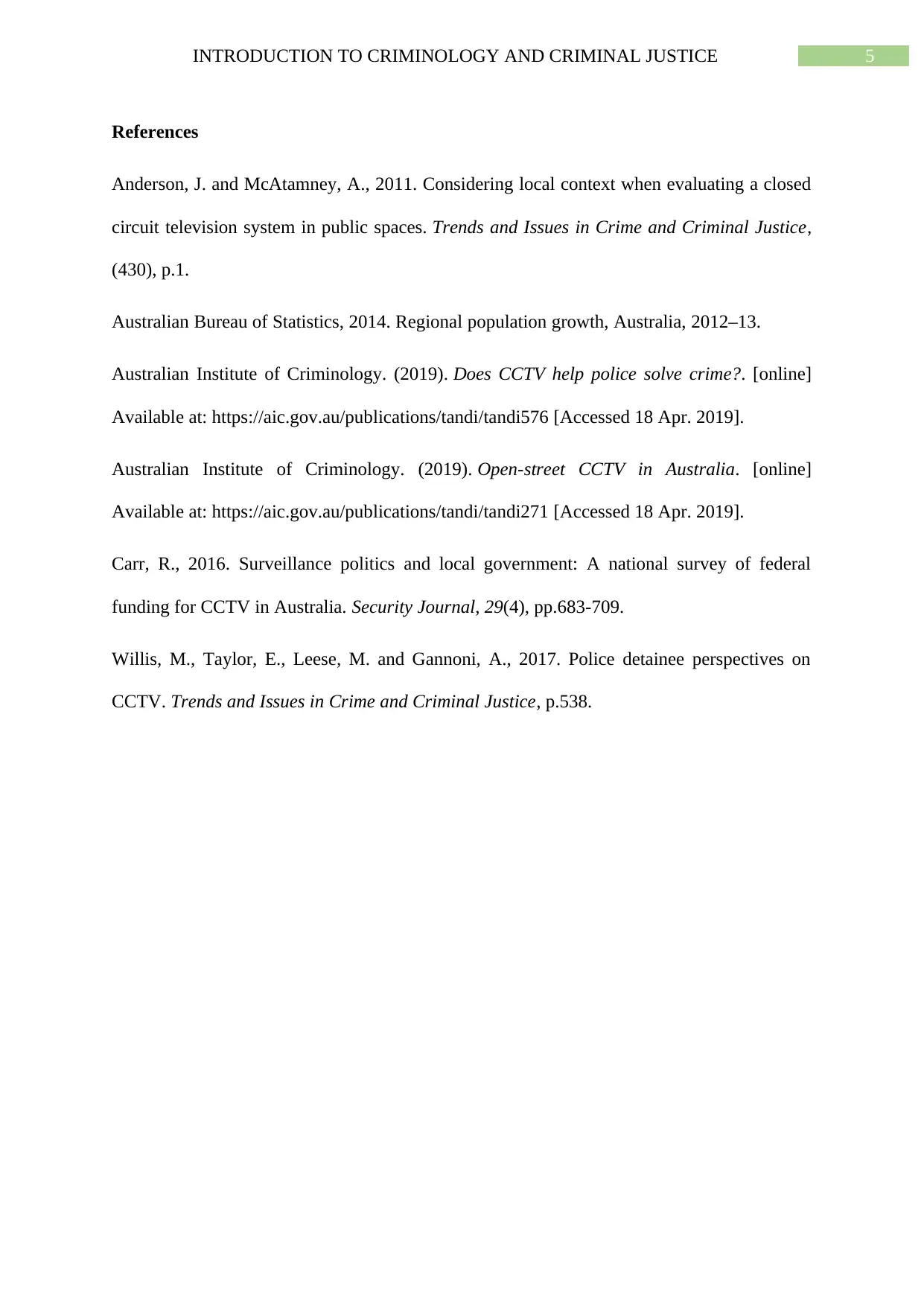
5INTRODUCTION TO CRIMINOLOGY AND CRIMINAL JUSTICE
References
Anderson, J. and McAtamney, A., 2011. Considering local context when evaluating a closed
circuit television system in public spaces. Trends and Issues in Crime and Criminal Justice,
(430), p.1.
Australian Bureau of Statistics, 2014. Regional population growth, Australia, 2012–13.
Australian Institute of Criminology. (2019). Does CCTV help police solve crime?. [online]
Available at: https://aic.gov.au/publications/tandi/tandi576 [Accessed 18 Apr. 2019].
Australian Institute of Criminology. (2019). Open-street CCTV in Australia. [online]
Available at: https://aic.gov.au/publications/tandi/tandi271 [Accessed 18 Apr. 2019].
Carr, R., 2016. Surveillance politics and local government: A national survey of federal
funding for CCTV in Australia. Security Journal, 29(4), pp.683-709.
Willis, M., Taylor, E., Leese, M. and Gannoni, A., 2017. Police detainee perspectives on
CCTV. Trends and Issues in Crime and Criminal Justice, p.538.
References
Anderson, J. and McAtamney, A., 2011. Considering local context when evaluating a closed
circuit television system in public spaces. Trends and Issues in Crime and Criminal Justice,
(430), p.1.
Australian Bureau of Statistics, 2014. Regional population growth, Australia, 2012–13.
Australian Institute of Criminology. (2019). Does CCTV help police solve crime?. [online]
Available at: https://aic.gov.au/publications/tandi/tandi576 [Accessed 18 Apr. 2019].
Australian Institute of Criminology. (2019). Open-street CCTV in Australia. [online]
Available at: https://aic.gov.au/publications/tandi/tandi271 [Accessed 18 Apr. 2019].
Carr, R., 2016. Surveillance politics and local government: A national survey of federal
funding for CCTV in Australia. Security Journal, 29(4), pp.683-709.
Willis, M., Taylor, E., Leese, M. and Gannoni, A., 2017. Police detainee perspectives on
CCTV. Trends and Issues in Crime and Criminal Justice, p.538.
⊘ This is a preview!⊘
Do you want full access?
Subscribe today to unlock all pages.

Trusted by 1+ million students worldwide
1 out of 6
Related Documents
Your All-in-One AI-Powered Toolkit for Academic Success.
+13062052269
info@desklib.com
Available 24*7 on WhatsApp / Email
![[object Object]](/_next/static/media/star-bottom.7253800d.svg)
Unlock your academic potential
Copyright © 2020–2025 A2Z Services. All Rights Reserved. Developed and managed by ZUCOL.





